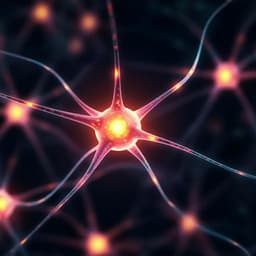
Environmental Studies and Forestry
Predicting microplastic masses in river networks with high spatial resolution at country level
D. Mennekes and B. Nowack
Discover groundbreaking research by David Mennekes and Bernd Nowack that presents a high-resolution model predicting microplastic masses in Swiss river networks. This innovative study highlights the critical role of catchment characteristics in microplastic transport and the necessity for precise, spatially distributed release data in large-area estimations.
~3 min • Beginner • English
Introduction
Plastics, particularly microplastics, are now detected across virtually all aquatic environments, transported extensively by rivers from sources far from sampling locations. While measurements provide localized snapshots, achieving adequate temporal and spatial coverage is difficult due to methodological inconsistencies and resource constraints. Existing large-scale transport models predominantly address macroplastics in oceans, and freshwater microplastic transport models are limited to single rivers or small catchments and require highly detailed hydrological and particle inputs that hinder broad application. This study addresses the gap by developing a high-spatial-resolution, country-scale model that links emissions to environmental exposure across river and lake networks. The research question is how microplastic emissions translate into transport, retention, and outflows across diverse catchments at national scale and how polymer properties compare with catchment characteristics (for example, lake presence and position) in determining fate. The authors hypothesize that focusing solely on polymer and sediment properties overlooks crucial catchment-scale drivers, and that high-resolution, spatially distributed emission inputs are essential for reliable country-scale assessments.
Literature Review
Past efforts include models such as nanoDUFLOW, INCA-microplastics, Full Multi, and NICE, which simulate fate and transport processes but are typically constrained to single rivers or limited systems and require detailed parameters (particle size, sediment properties, hydraulics, critical shear stress). Large-area, high-resolution microplastic models for freshwater networks are lacking; most country- or continental-scale applications exist only for macroplastics in marine contexts. Measurement studies provide important baseline data but vary widely in methods and quality, complicating model validation. Overall, the literature indicates a need for scalable, data-efficient freshwater microplastic models that consider both polymer properties and catchment features (for example, presence and size of lakes, tributary structure).
Methodology
The authors coupled a spatially resolved microplastic release model with a fate and transport framework over a country-scale hydrological network. Case study: Switzerland. Scope: the full river network and lakes, including focused analysis of Rhine, Rhône, and Doubs catchments. Seven polymers were simulated: EPS, PP, LDPE, HDPE, PS, PVC, and PET. Emission inputs: polymer-specific, spatially distributed annual emissions (converted to mass per second) directly to water bodies from Kawecki and Nowack, allocated by proxies (population density, land use, construction, traffic). Hydrological network: vectorized river and lake segments with downstream connectivity ensuring logical transport. States and processes: microplastic mass is tracked in three states per segment and polymer—suspension, sediment, and deep sediment (accumulation). Default: emissions enter suspension, then may sediment. Sedimented mass can (i) be buried (accumulate), (ii) resuspend, or (iii) be transported downstream with sediments. Transport: advection-dominated; steady-state per 1-second timestep; mass per second entering a segment equals mass per second exiting after accounting for retention processes. Segment mass is calculated as mass per second multiplied by residence time in the segment (segment length divided by average flow velocity). Lakes are treated under steady-state at 1 s: inflow plus direct emissions equals outflow after retention. Fate parameters: sedimentation (f_sed) and accumulation (f_acc) applied per segment and polymer. Rivers: f_sed,river = 1 − (1 − k)^L, where k is a per-second sedimentation factor derived from literature (notably Besseling et al. using 5 µm size class as a proxy) and L is travel time (segment length/velocity). Resuspension in rivers set at 3%. Long-term burial in rivers: default 10% of sedimented mass, capped at a maximum rate of 1×10^-8 s^-1. Lakes: f_sed,lake parameterized as a function of lake surface area A (km²), differing by polymer (for example, 0.95×(1 − e^(−0.004×A)) for LDPE/HDPE/PS; 0.95×(1 − e^(−0.012×A)) for PVC/PET; reduced factor for EPS and PP). In lakes, long-term accumulation assumes all sedimented mass is transferred to deep sediments. Scenarios analyzed: S0 (no retention), Slake (retention only in lakes), S15lakes (retention only in 15 largest lakes), Sall (retention in both lakes and rivers). Outputs: steady-state masses in suspension, sediments, and accumulation for each segment; catchment outflows in kg per year; retention fractions. Validation: comparison against reported surface trawl measurements converted to mass flows for Rhine and Rhône, and comparison of polymer composition patterns. Temporal resolution: steady-state per second calculations aggregated to annual metrics; underlying emissions are annual (2014).
Key Findings
- Spatial distribution: Highest suspended microplastic masses occur downstream towards national borders, especially the Rhine near Basel; mountainous and remote small rivers exhibit low to no predicted pollution. Pollution is concentrated along relatively few river sections. Normalized polymer-specific river segment pollution patterns are highly correlated across polymers (correlation coefficient ~0.9).
- Retention at national scale: Approximately 50% of directly emitted microplastic mass to Swiss waters is retained within Switzerland across all polymers (steady state, 2014 emissions). About 33% is retained in lakes; notably, 99% of lake retention occurs in the 15 largest lakes (only ~7% of all impacted lakes). Rivers retain about 17% overall, with polymer dependence: near 0% for EPS up to ~40% for PET. Heavier polymers (PVC, PET) contribute most to additional river retention from Slake to Sall.
- Catchment outflows (kg per year, suspension plus sediment transport): Rhine ~4,565; Rhône ~300; Doubs ~61. These three account for ~88% of Switzerland’s microplastic outflow. Remaining outflows: Lago Maggiore (Ticino River) ~327 (~6%), smaller cross-border rivers (~2%), Breggia (~2%), Inn (~1%), others minor.
- Sediment transport share of outflow: About 2–9% of outflowing microplastic mass is transported via sediment, with higher percentages for catchments with higher total transport (for example, Rhine).
- Role and position of lakes: Lake Constance (Rhine) and Lake Geneva (Rhône) each reduce inflowing microplastic mass to about one-third via sedimentation. In the Rhône, Lake Geneva lies near the catchment outlet and strongly retains upstream inputs; however, downstream emissions from the City of Geneva largely determine border outflow, especially for dense polymers (PVC, PET). In the Doubs (small lake areas), river sedimentation is relatively more important for less-dense polymers.
- No simple retention–distance relation: Across 502 random river segments, retained fractions versus distance to outlet vary widely by catchment. The Rhône approximates a logarithmic trend due to Lake Geneva; the Rhine shows complex patterns with distinct tributary influences (Aare, Reuss, Limmat). Small to medium lakes can significantly influence retention.
- Model–measurement comparison: At the Rhine–Germany border, modeled outflow was ~0.13 g s^-1 (spherical assumption) versus ~1.2 g s^-1 measured; or ~0.02 g s^-1 under a fragment assumption. At the Rhône–France border, modeled ~0.009 g s^-1 versus ~0.12 g s^-1 measured. Polymer composition dominance of PE (HDPE, LDPE) and PP is captured; PS comparisons are uncertain due to classification and mass–number discrepancies (EPS).
Discussion
Findings demonstrate that catchment characteristics—especially lake presence, size, and position relative to emission sources—and network connectivity can be as influential as polymer density in determining microplastic fate. Approximately half of directly emitted microplastic mass is retained nationally, with lakes dominating retention and rivers contributing additional, polymer-dependent retention. The lack of a simple relationship between retention and river length underscores the necessity of high spatial resolution and spatially distributed inputs for reliable national-scale assessments. Differences among catchments (for example, the lake-dominated Rhône versus the tributary-dominated Rhine) highlight the importance of site-specific hydrology. Model–measurement discrepancies likely arise from conservative emission scope (direct-to-water only within Swiss territory), missing processes (macroplastic fragmentation to microplastics, land-to-water transport, atmospheric deposition), and measurement uncertainties and conversion assumptions. Nevertheless, the model reproduces key patterns such as PE/PP dominance and demonstrates how targeted downstream emission reductions (for example, Geneva city below Lake Geneva) could more effectively decrease cross-border outflows. The approach offers a framework to estimate exports, identify hotspots, and assess policy scenarios at high spatial resolution.
Conclusion
This work presents the first country-wide, high-resolution modeling of microplastic mass transport and retention in interconnected river–lake networks, including polymers less dense than water. Lakes are identified as the primary retention sites, potentially retaining up to an order of magnitude more mass than rivers, with retention strongly dependent on lake size and location. The model is adaptable to other regions, scalable in process detail (including size classes), and useful for identifying pollution hotspots and evaluating policy or management scenarios. Future research should refine the role of lakes and dams (varying sizes, depths, constructions, hydrodynamics), improve size-specific release data and fate parameters (sedimentation, resuspension), and integrate macroplastic fragmentation and soil-to-water pathways to deliver a full plastic fate framework. Enhanced, process-oriented measurement campaigns aligned with hydrological principles (paired inflow–outflow segments, flow-timed sampling) are essential to calibrate and validate such models.
Limitations
- Emission scope: Only direct emissions to water within Switzerland were modeled; cross-border upstream sources, macroplastic fragmentation to microplastics, land-to-water transport, and atmospheric deposition were not included (the latter considered minor nationally). Swiss shares of total catchment areas are 77% (Rhine) and 67% (Rhône), leading to underestimation of total outflows.
- Temporal resolution: Although computed at 1 s steady-state timesteps, inputs are annual and outputs are yearly, not capturing short-term events like floods that can alter transport and resuspension.
- Size representation: Model tracks mass in a single representative microplastic size class; release data lack size distributions, and particle-number-based toxicity assessments are not addressed.
- Parameter uncertainty: Sedimentation and resuspension factors are estimated from limited and sometimes contradictory literature, especially for less-dense polymers; burial rates are simplified (rivers: 10% with a cap). Lake processes are simplified to area-dependent sedimentation with full burial of sedimented mass.
- Lake concentration comparison: Lack of robust process understanding to convert inflow masses to lake concentrations and high measurement uncertainties limited validation for lakes.
- Hydrodynamic simplifications: Average velocities and steady-state assumptions may not capture complex hydrosedimentary dynamics, especially in lakes and during high-flow conditions.
Related Publications
Explore these studies to deepen your understanding of the subject.







